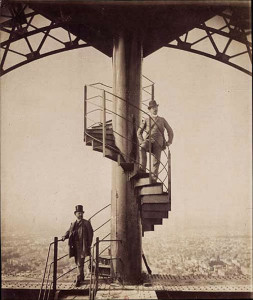The Eiffel Tower is the most recognizable landmark in Paris and is known worldwide as a symbol of France. Named after its designer, Gustave Eiffel, it is a premier tourist destination, with over 5.5 million visitors per year. The tower received its 200,000,000th guest on November 28, 2002.
The structure was built from 1887-1889 as the entrance arch for the Exposition Universelle (1889), a World’s fair at the centennial celebration of the French revolution. It was inaugurated on March 31, 1889, and opened on May 6. 300 steel workers joined together 18,038 pieces of steel, using two and a half million rivets. Considering the safety standards in place at the time, it is remarkable that only one worker died in the construction of the tower, during the installation of the lifts (elevators).
The tower is 300 metres tall, (986 feet), not including the television antenna on top, which adds another 20 meters, and weighs over 10,000 tonnes (over 21,000,000 pounds). When it was built it was the highest structure in the World. Maintenance on the tower includes 50 tons of dark brown paint every 7 years. Depending on the ambient temperature, the Eiffel Tower will change height by several centimetres because of contraction and expansion of the metal.
Perhaps predictably, the tower met with resistance from the public when it was first built, many thought it would be an eyesore. Today it is widely considered to be one of the most striking pieces of architectural art in the world.
One of the great Hollywood movie cliches is that the view from a Parisian window always includes the Eiffel Tower.
Originally, Eiffel had a permit to leave the tower standing for 20 years, but as it proved valuable for communication purposes, it was allowed to stay after the end of the permit.
See the Eiffel Tower from above,
[wl_geomap]
Events
- On January 12, 1908, the first long-distance radio message was sent from the tower.
- Father Theodor Wulf in 1910 took observations of radiation at the top and bottom of the Eiffel Tower, discovering more than was expected at the top, and thereby detecting what are today known as cosmic rays.
- In 1925, the con artist Victor Lustig twice “sold” the Eiffel Tower for scrap.
- In 1929, the Tower lost the title of the World’s tallest structure when the Chrysler Building was completed in New York.
- When Adolf Hitler visited Paris in World War II, the lifts were put out of action by the French so that he would have to climb the 1792 steps to the summit – the part to repair them was allegedly impossible to obtain because of the war, though it was working again within hours of the departure of the Nazis. He chose to stay on the ground.
- On January 3, 1956 a fire damaged the top of the tower.
- In 1959 the present radio antenna was added to the top.
Planning to visit The Eiffel Tower?
Join our tour and visit the Iron Lady at night!
